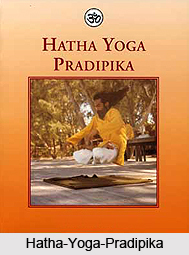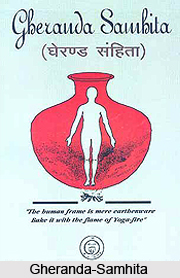Hatha Yoga Pradipika is one of the best known and most widely available treatise on hatha-yoga. Pradipika literally means "that which sheds light", and hence the title of this work translates as "Light on, or illumination of, hatha-yoga". The author of this detailed work is suppose to be Svatmarama Yogendra in the fourteenth-century C.E.
 However, Hatha Yoga Pradiika is better known as the compilation rather than the original work as much of its material resembles, or even precisely duplicates, passages from other hatha manuals. Many inspired works are attributed to Goraksha.
However, Hatha Yoga Pradiika is better known as the compilation rather than the original work as much of its material resembles, or even precisely duplicates, passages from other hatha manuals. Many inspired works are attributed to Goraksha.
Hatha Yoga Pradipika comprises a total of 389 Shlokas (A Sanskrit verse usually consisting of two pithily composed lines). The work is divided into four chapters containing 67, 78, 130 and 1 14 shlokas respectively.
The Initial most and the most important chapter or "prathamopadesa" deals mainly with the right environment for hatha practice, certain ethical requirements, and the yoga-asanas or `postures`.
The Dvitayopadesa (second lesson) principally concerns pranayama as the `harnessing` of vital energy through various modes of `retention` (Kumbhaka). It also discusses the sat-karmani (six cleansing acts) which deals with the purification of body, vital channels (nadis) and rectifying all Doshas.
In Trtiyopadesha (third lesson), the extensive coverage of mudra (sealing) is addressed.
Chaturtho-padesa (fourth lesson) discusses the practice of nada-anusandhana (meditation upon the inner sound). There is detailed description on state of samadhi, which in its highest form is the ultimate goal of yoga and which leads to that goal.
The crisp description of Hatha Yoga Pradipika is assisted by several commentaries on the same work. The best known work is that of Jyotsna (`Light`, Illumination`) of Brahmananda. This work itself quotes extensively from other works of Indian philosophy. Brahmananda`s commentary ackowledges how Svatmarama`s text relates to the broader context of yoga and to the ashtanga yoga system of Patanjali in particular.
Other major commentaries include those by Umapati, Mahadeva, Ramananda Tirtha, and Vrajabhusana.
There have been many applaudable works as the English transalation of the work along with the commentaries.
Gheranda-Samhita
This work is approximately dated to the late seventeenth-century and is generally agreed to be later than the Hatha Yoga Pradipika from which several shlokas are borrowed.
The Gheranda-Samhita is a work of total 354 Shlokas, divided into seven upadeshas. Each upadesha deals with an aspect of the sevenfold system (sapta-sadhana) dictated by the sage Gheranda to his disciple, Chandakapali.
The seven aspects are:
(1) Sat-karmani
(2) Asana
(3) Mudra
(4) Pratyahara (sense-withdrawal)
(5) Pranayama
(6) Dhyana (meditation)
(7) Samadhi.

In the second Shloka of the text, Chandakapali asks Gheranda to teach him the way to the knowledge of truth. In response to the query the sage Gheranda told him about Ghatastha-yoga. Since ghata means vessel, pot or container, this may be translated as yoga of the vessel (of the Self). The `vessel` here is not simply the gross physical body but the whole psychophysical organism through which the Self (better known as atman or Purusha) experiences the world.
Goraksha-Shataka
Goraksha or otherwise known as Gorakshanatha or Goraknath is one of the principal gurus named in hatha-yoga lineages. This legendary and mythological Guru literally means `cow-protector` and is also one of the titles of Shiva. Numerous works on hatha-yoga are attributed to Goraksha. Several of these are merely slightly different versions of the same text.
The major ones include the Siddha-Siddhanta-Paddhati (Path of the adepts doctrine), Goraksha-Siddhanta-Sangraha (Compedium of Goraksha`s perfect doctrine), Goraksha Vachana Sangraha (Compedium of Goraksha`s instruction), Goraksha-Vijaya (Goraksa`s victory), Amaraugha-Prahodha (`Undying flood of wisdom`), as well as many others. One of the major works is the Goraksha-Shataka that literally means One hundred verses of Goraksa. The Goraksha-Shataka actually comprises 101 Shlokas, which outline the practices of asana, prana-samrodha (as pranayama), Mudra, and japedomkara (repetition of the syllable om), as well as mentioning certain concepts relating to yoga`s subtle physiology, such as the Kanda, Nadi, chakras, Kundalini etc.
Shiva-Samhita
The Shiva-Samhita or Collection of the knowledge of Shiva, is presented as though directly spoken by the deity Shiva himself. Inspite if the fact, the ideas contained within it extend much farther back, It is likely to date from a similar period to the Gheranda-Samhita.
The author of this textual works establishes a yoga doctrine, which is influenced both by the Advaita (non-dualist) school of Vedanta and by later Tantric system.
The 645 Shlokas of the text work are categorized in the five chapters, making it much longer than the other main texts.
First chapter provides an introduction to Advaita metaphysics, and states that it is the yogi`s task to realise the unity of the individual self and the universal Self, in order to perceive the true nature of reality. This can only be done by `dissolving` the veil of Maya phenomenal existence.
The second chapter describes certain aspects of the human subtle bodily matrix.
Chapter three includes some discussion of pranayama and asana. The fourth chapter is concerned with mudra, and the Fifth, being the longest chapter, includes further descriptions of the six major chakras. It also includes the discussion on four varieties (or aspects) of yoga, namely mantra, hatha-, lava- and raja yoga.
Yoga-Sutra and Yoga-Bhasya
The year of composition of Yoga sutra is unknown. However, some experts have approximately estimated it to be as early as the fourth century B.C.E., while others have placed it as late as the third century C.E. The text comprises of 196 sutras distributed over four chapters.
Sutra literally means `thread` and `that which sews`. It refers to a particularly terse form of composition, which usually requires an accompanying commentary.
Yoga-Sutra is the systematic codification of Knowledge regarding Yoga. All the schools, including Hatha yoga are drawn from this basic foundation. Hence, Yoga sutra is not necessarily a work of hatha-yoga, but a broad overvoiew from which hatha yoga is drawn.
This textual work is attributed to the sage Patanjali. Hence, it is sometimes referred to as the Patanjali -Sutra, and its doctrine characterised as Patanjali-yoga.
The principal practical doctrine of Yoga Sutra involves an `eight-limbed` (ashtanga) system, those limbs being:
(1) Yama (restraint).
(2) Niyama (secondary restraint)
(3) Asana
(4)Pranayama
(5)Pratyahara
(6)Dharana (concentration)
(7) Dhyana
(8) Samadhi.
Hatha-yoga treatises is broadly based on this system with some uniqueness of its own. Hatha texts yield far greater emphasis on the third and fourth limbs of Asana and Pranayam. Hatha-yoga regards pranayama is regarded as the key practice, with the other successive limbs assisting in prana-retention.
No mention is made in the Yoga-Sutra of mudra, nor of the notion of Kundalini-Shakti`s ascension along Sushumna-nadi. Although much more emphasis is placed on the various modes of meditation, than in Hatha Texts. Despite these discrepancies Hatha- and Patanjali-yoga are complementary in all major respects. Hence it is often referred by Hatha Yogis for technical clarifications.
Sage Vyasa from around fifth century has authored the earliest and best known commentary on the Yoga-Sutra. It is most commonly referred to as the Yoga-Bhashya, a bhashya being an explanatory composition which `fills out` or `unpacks` information contained in a sutra text, but which itself may require further commentaries.
Other names for Vyasa`s commentary include the Vyasa-Bhanya and the Samkhya-Pravachana-Bhashya (Instructive exposition of Samkhya`), Samkhya being a particular Indian philosophical tradition which provides the metaphysical basis for Patanjali`s System.
Sat-Chakra-Nirupama
Sat-Chakra-Nirupama comprises of 55 Shlokas describing six main chakras of the human `subtle body` (sukshma-sharira) plus the Sahasrara Padma (`thousand-petalled lotus`) at the crown of the head.
Shat Chakra Nirupama is referred for studies of seven Chakras, as it is through them that the Kundalini Shakti arises in a human body. Before achieving such a state, a proper alignment of the seven chakras is mandatory.
Even if it is not necessarily a work on Hatha Yoga, it is definitely a enriching assistance to understand a highly intricate and deep knowledge of Hatha Yoga.



